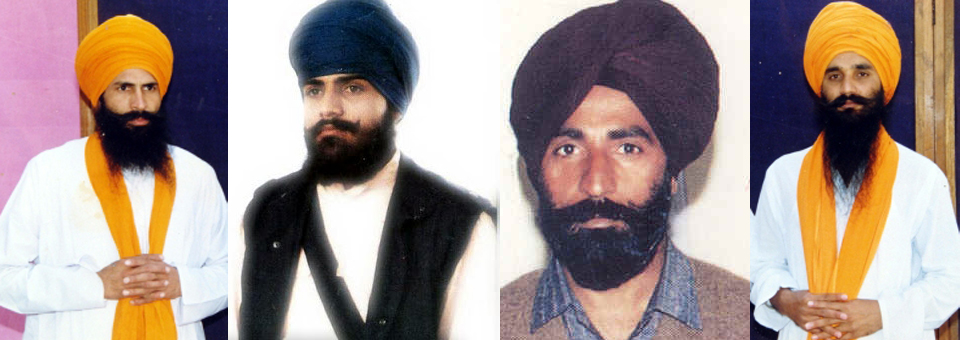Yesterday was the martyrdom anniversary of Sikh freedom fighters Harjinder Singh ‘Jinda’ and Sukhdev Singh ‘Sukha’, an occasion that has been commemorated since their execution by the Indian State in 1992. The fervour with which both men are remembered at the Akal Takht (the Timeless Fortress) is reflective of the manner in which they lived and ultimately the manner in which they met their fate; their uncompromising bravery and fearless attitudes were rare in a World where it is easier to remain silent, turn a blind eye, or even collaborate with those who seek to oppress. However, this humble act of rememberance can be overshadowed when we do not understand what it was that they stood for and ultimately what it was that they died for.
Growing up, my bedroom wall adorned posters of footballers Eric Cantona, Mark Hughes and Bryan Robson alongside such Sikh freedom fighters as Gurjant Singh ‘Budhsinghwala’ and General Labh Singh. I used to take great time in explaining carefully to my school-friends (most of whom were non-Sikh) just who these men were and what was taking place in the Punjab at that time. I would begin by explaining the injustice of the partition of Punjab instigated by the British empire, followed by the decades of systemic oppression suffered in the Punjab at the hands of the central Government, culminating in the invasion of the Darbar Sahib at Amritsar. I learnt to choose my words carefully because it was so easy for others to casually label the Punjab’s Sikhs of the 20th century as militants, separatists and extremists – words which carry much weight, all of which is intended to paint a negative image. In the west, this is all too easy a conclusion to draw of combatants in third World countries, especially when they reside in nations which garner little positive exposure.
The manner in which people are represented by the media goes a long way towards setting public opinion either in favour of them or against. In terms of the Sikh struggle over the last seventy years, it is a battle that has been almost entirely lost both within and outside of the community. I have always been able to understand this situation when it comes to non-Sikhs – we are a relatively new people without an established period of stability in the country of our origin and so representing the intricate philosophies and complex happenings that have led us to this point is always going to be a tough ask when speaking to those whose experience of us is limited. However, the generally apathetic manner in which the Sikh community itself looks at the role played by the likes of Sukha and Jinda has always surprised me. Sikh history is replete with personalities who have fought and died opposing oppression and injustice, from the Gurus themselves to Kartar Singh Sarabha and Bhagat Singh a hundred years ago, all of whom were labelled as outlaws and ‘terrorists’ in their own time periods. It should come as no surprise to us that the freedom fighters of the 1980s and 1990s in Punjab have been similarly categorised and it certainly should not be leading us down the path of becoming silent bystanders or apologists when it comes to talking about them.
The biggest problem that Sikhs face in this regard is a lack of comprehension of the principles of governance espoused by the Guru, of the doctrines that determine use of the sword, and the very art of war that the House of Guru Nanak deftly played throughout 239 years of leadership in this World. As a people, we have failed to grasp just what it was that Sikh freedom fighters were struggling to achieve not just in the last three decades, but in the centuries that preceded it. The ultimate battle for the Sikh is to bring about a utopian society based on the freedom of all people and the destruction of hierarchical systems that curtail our rights as individuals. Whilst this might appear to be more obvious to some when we think of Guru Arjan’s opposition of Jahangir, it is in essence the same opposition which the men who adorned posters on my bedroom wall were making of the Indian political administration. In that same vein, some of those present at the commemorative ceremony at the Akal Takht yesterday continue to work towards that struggle such as recently released political prisoner Kulbir Singh Barapind, as does our very own writer here at Naujawani.com, Ranjit Singh Kuki Gill who was both a friend and co-accused of Sukha and Jinda, who continues to work towards the betterment of the people of Punjab (and beyond) and in opposition of the injustice that is meted out by those in power.
It hasn’t been until recent years that the work of writers including Gurtej Singh, Ajmer Singh and Joyce Pettigrew have reached out to a wider audience of Sikhs; younger generations in particular are beginning to understand why Sukha, Jinda, Gurjant Singh Budhsinghwala and General Labh Singh should be termed freedom fighters. But it is still a long way from Sikhs as a people coming to understand the battle that was fought and which continues to rage today, albeit on a different field. We are still some way off fully appreciating what it was that these people stood for and achieved. Rememberance is an important tool to keep memories alive and tell a people’s history, but it is ill-served alone when memories continue to be made anew today, and when history has not yet completely come to pass.




